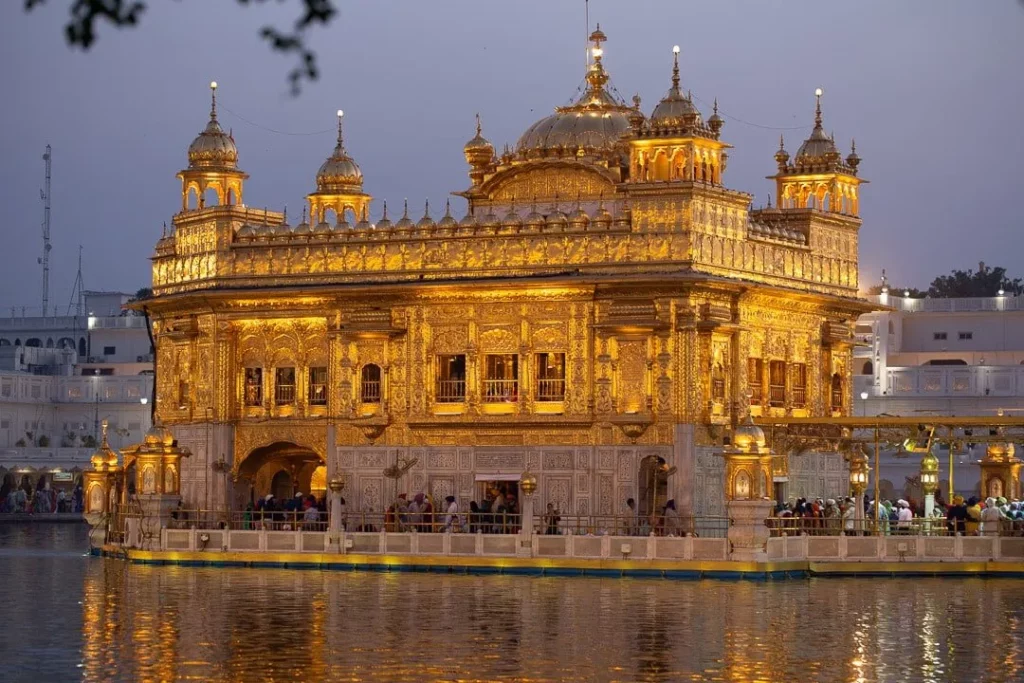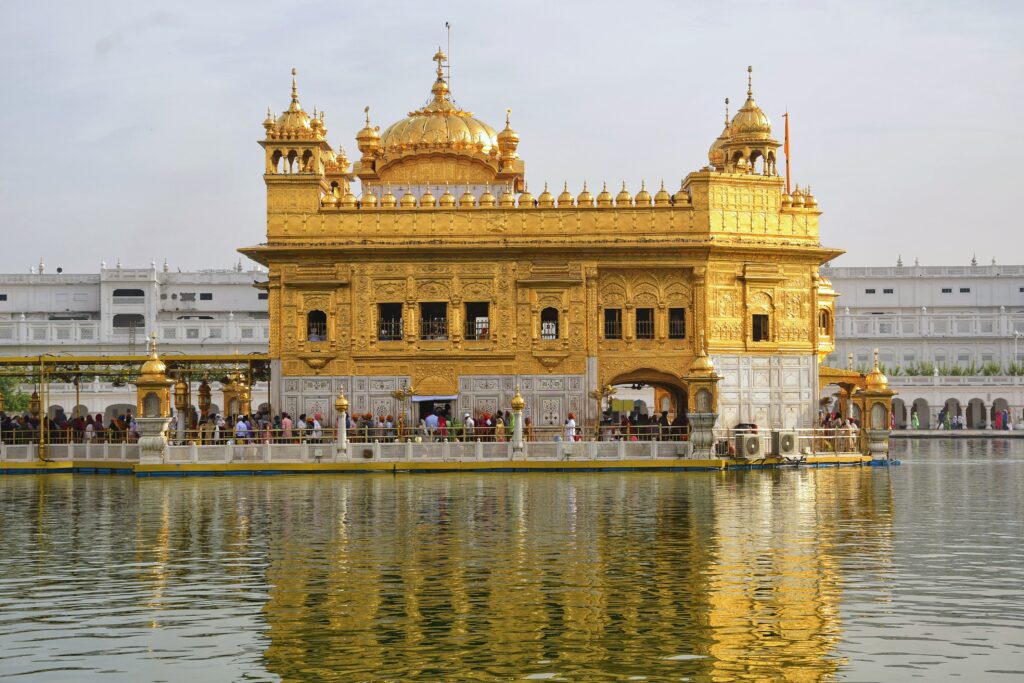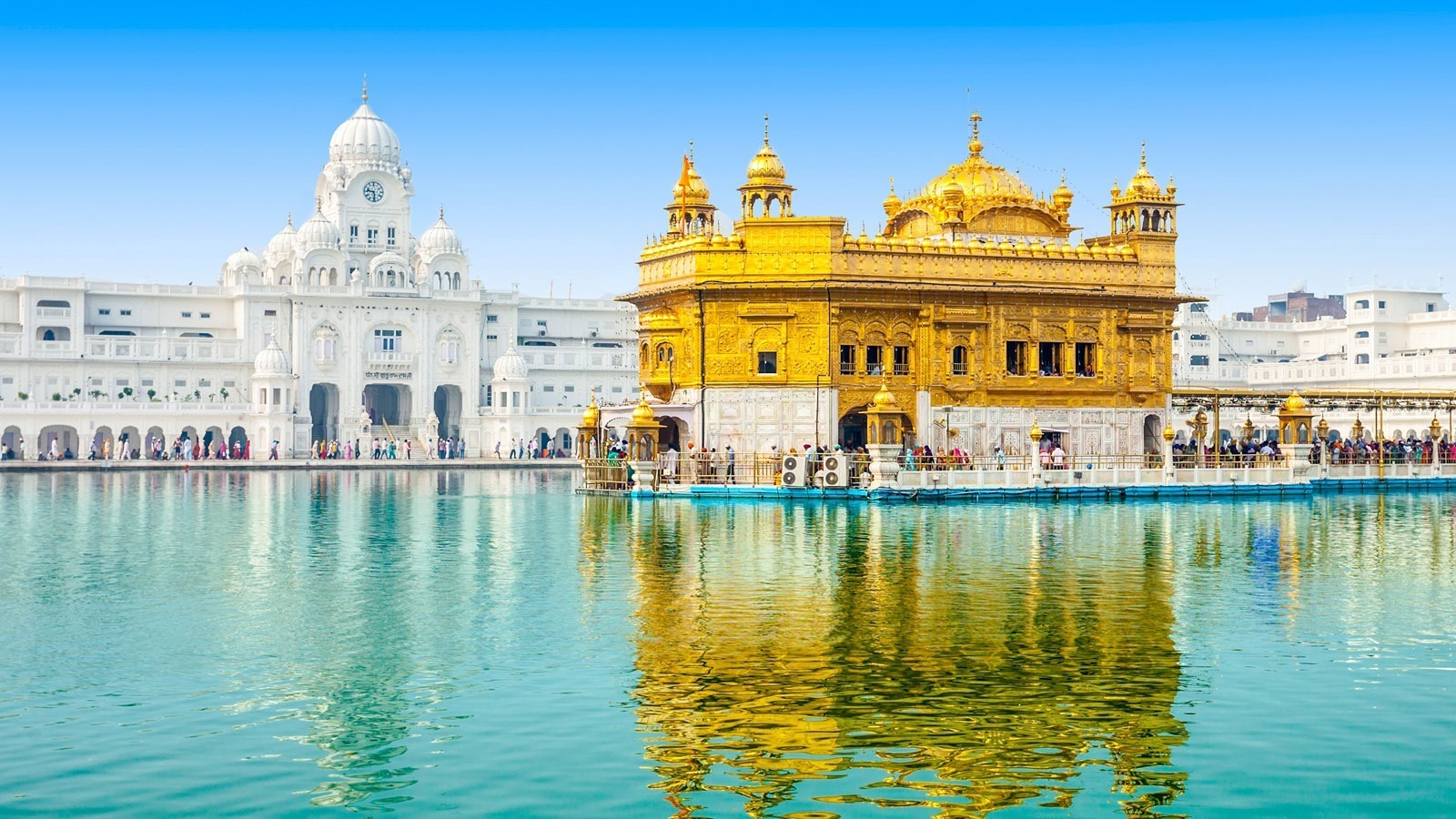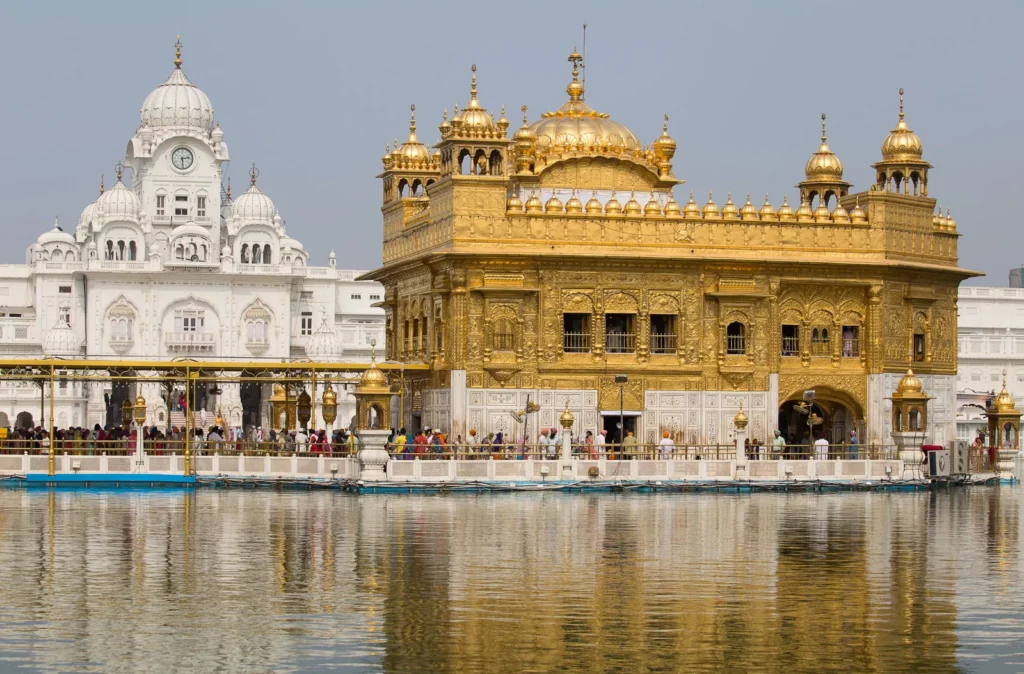
The Golden Temple, Amritsar, Punjab
The Golden Temple is a very special place in India. It’s also known as Sri Harmandir Sahib or Darbar Sahib. This temple is not just a building; it’s like a shining golden jewel that attracts people from all over the world. Discover the Golden Temple in Amritsar—a serene haven drawing countless visitors seeking peace and spirituality. Beyond its breathtaking beauty, it’s a place where people find solace amid life’s hustle. This sacred sanctuary welcomes everyone, offering a chance to embrace inner peace and a spiritual connection, making each visit meaningful and serene.
Namaste 🙏 नमस्ते
Secure your visit • अपनी यात्रा सुरक्षित करें
Historical background and Architectural splendor
Guru Nanak, the first Sikh guru, is said to meditate at the holy site where Harmandir Sahib was built. The sacred tank Amrit Sarovar was founded in 1577 by Guru Ram Das, the fourth Sikh guru. And the construction of the gurudwara was initiated by the fifth Sikh guru – Guru Arjan.
Guru Arjan designed it to be built in the centre of the tank. The construction started in 1581 and took almost eight years to complete. Then, he installed the Adi Granth, the holy scripture of Sikhism, inside the temple. The Akal Takht in the complex was constituted by the sixth guru, Guru Hargobind.
Guru Arjan was arrested by the Mughals after the construction. And Harmandir Sahib Amritsar fell into the hands of the enemy. Guru Gobind Singh liberated it later, in the 18th century. He was the tenth Sikh guru.After Guru Gobind Singh’s death, Harmandir Sahib had been under attack by Islamic rulers. It was in 1762 when this religious heritage was blown away. Maharaja Ranjit Singh rebuilt it in 1809 and adorned it with gold foil. Thus, Harmandir Sahib came to be called the Golden Temple.It was again destroyed in 1984 when the government wanted to capture militant Sikhs hidden inside. Later, from 1995 until 1999, it was rebuilt
While the Golden Temple dome is made from pure gold, the inner walls and door panels also exhibit goldwork. Copper sheets have been engraved with delicate designs and then covered with gold leaves. Even the ceiling is adorned with precious stones and gold.
The first floor of the Golden Temple is set up at a lower level below the ground. It’s decorated with rare paintings and marble sculptures. The stairs to the shrine go downwards, signifying humble living.
It’s a blend of Indian and Mughal architectural styles. You’ll find symbolisms of life everywhere in Harmandir Sahib in Amritsar. They’re in paintings, in the form of birds, animals and flowers.

Religious Significance
For many people, the Golden Temple is like a spiritual heart. It's the holiest place for Sikhs, a group of people in India. Sikhs believe in treating everyone equally, spreading love, and helping others. The temple represents these ideas, and inside, they keep their special holy book, the Guru Granth Sahib.


Festival and Celebrations
The Golden Temple is always buzzing with excitement, especially during festivals like Gurpurab,Vaisakhi, Diwali, Hola MohallaBandi Chhor DivasGuru Arjan Sahib Ji Shaheedi Diwas,Guru Nanak Dev Ji Gurpurab,Guru Gobind Singh Ji Gurpurab,Martyrdom Day of Guru Tegh Bahadur Ji and Baisakhi.
Surroundings area & attractions
- Jallianwala Bagh: A poignant memorial commemorating the tragic massacre in 1919, it provides insights into India's struggle for independence.
- Akal Takht: One of the five seats of authority for Sikhs, it is a significant religious institution located within the Golden Temple complex.
- Durgiana Temple: Often called the "Silver Temple," it's dedicated to Goddess Durga and reflects architectural similarities to the Golden Temple.
- Wagah Border: Experience the vibrant Wagah Border ceremony, a daily military ceremony marking the closing of the India-Pakistan border.
- Gobindgarh Fort: A historic fort showcasing the rich history of Punjab through museums, exhibitions, and cultural performances.
FAQ
The Golden Temple, also known as Sri Harmandir Sahib, is located in the city of Amritsar, in the state of Punjab, India.
The Golden Temple is the holiest shrine in Sikhism and is considered the spiritual and cultural center of the Sikh religion. It symbolizes equality, brotherhood, and the central tenets of Sikh philosophy.
The Golden Temple is adorned with gold-plated domes, which give it its distinctive golden appearance. The architecture of the temple is adorned with intricate marble work and precious stones.
The foundation of the Golden Temple was laid by Guru Ram Das, the fourth Sikh Guru, in the 16th century. It was later completed by Guru Arjan Dev, the fifth Sikh Guru.
The Amrit Sarovar is a sacred pool surrounding the Golden Temple, and its waters are considered holy by Sikhs. Devotees take a dip in the sarovar as part of their spiritual cleansing and purification rituals.
The Golden Temple follows a strict schedule of rituals and ceremonies, including the continuous recitation of the Guru Granth Sahib (the Sikh holy scripture), prayers, kirtan (devotional singing), and langar (community kitchen) where free meals are served to all visitors regardless of religion, caste, or creed.
Visitors to the Golden Temple are required to cover their heads with scarves or head coverings as a sign of respect. Shoes must be removed before entering the temple complex, and appropriate attire is expected to maintain the sanctity of the sacred space.
The langar at the Golden Temple is one of the largest community kitchens in the world, serving free meals to thousands of visitors every day. This tradition of communal dining emphasizes the principles of equality, humility, and selfless service in Sikhism.
The Golden Temple celebrates various Sikh festivals with great enthusiasm, including Gurpurabs (birthdays of Sikh Gurus), Vaisakhi (Sikh New Year), Diwali (Festival of Lights), and Hola Mohalla (Sikh martial arts festival).
Yes, the Golden Temple is open to people of all faiths and backgrounds. Visitors are welcome to explore the temple complex, participate in the rituals, and experience the spiritual atmosphere of the sacred site.
The Golden Temple was built to be a place of worship and congregation for Sikhs. The construction of the temple began in the 16th century under the guidance of Guru Ram Das and was completed by Guru Arjan Dev. It was designed to be a symbol of Sikh ideals and principles.
Yes, the Golden Temple is open to visitors throughout the day and night, every day of the year. The temple complex has minimal closure times for cleaning and maintenance, but otherwise, it welcomes visitors around the clock.
The Golden Temple is illuminated with lights and floodlights, creating a stunning visual spectacle, especially during the evening and night. The golden domes and reflective waters of the Amrit Sarovar enhance the beauty of the temple complex.
Yes, visitors of all faiths are welcome to participate in the langar at the Golden Temple. Volunteers prepare and serve simple vegetarian meals to all visitors, regardless of their background. It is considered a humbling and egalitarian experience.
Yes, visitors are expected to maintain a respectful and reverent demeanor while inside the temple complex. Loud conversations, smoking, drinking, and any form of disrespect towards the sacred space or its inhabitants are strictly prohibited.
The management and maintenance of the Golden Temple are overseen by the Shiromani Gurdwara Parbandhak Committee (SGPC), which is responsible for ensuring the smooth functioning of the temple complex, including its religious, administrative, and charitable activities.
Yes, visitors have the option to make donations or offerings to support the ongoing operations and charitable initiatives of the Golden Temple. These contributions help fund langar, maintenance, and other community welfare projects.
The architecture of the Golden Temple reflects a unique blend of Hindu, Islamic, and Sikh architectural styles. The four entrances symbolize the openness and inclusivity of Sikhism, welcoming people from all directions and walks of life.
Amritsar offers several other attractions for visitors, including the historic Jallianwala Bagh, the Durgiana Temple, the Partition Museum, and the Wagah Border ceremony, which marks the border between India and Pakistan.
Visitor information
Entry Fee: No fee
Timings :
- 4am to 10pm
Darshan Days- All days
Address:
Golden Temple Rd, Atta Mandi, Katra Ahluwalia,, Amritsar, Punjab, 143006, India
Notable Events and Incidents
- Massacre of Sikhs :1762
- Jallianwala Bagh Massacre: 1919
- Operation Woodrose :1986
- Opening of the Guru Nanak Darbar:2016
- Langar Tradition
Connectivity :
- By bus – Golden Temple Trust operates a free bus service to Harmandir Sahib. You can take it from different parts of the city.
- By auto/rickshaw – Auto-rickshaws and cycle rickshaws are readily available in Amritsar. You can get them all around the city and visit Harmandir Sahib.
- By taxi/cab – You can also book taxis or cabs to Amritsar Golden Temple from the top car rentals in Amritsar. They’re the most comfortable way to visit the place. You can hire them for the whole day.
- Local Transportation: Auto-rickshaws, cycle-rickshaws, and taxis are readily available in Deoghar for local travel. Many devotees prefer walking to the temple complex due to its proximity to the main town.
